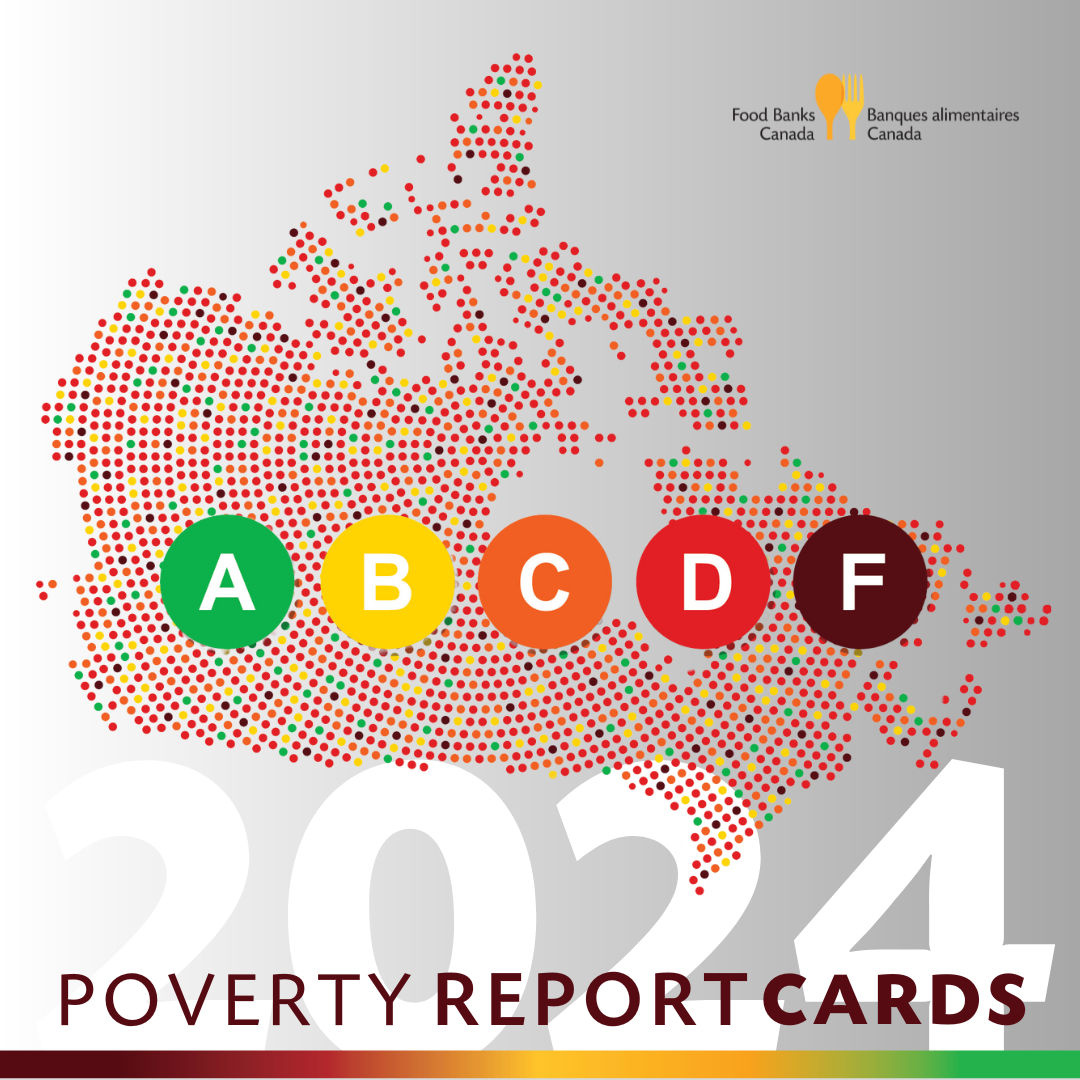Poverty Report Cards: Canada is missing the mark.
With food bank use continuing to rise in Canada, more and more people are looking to their governments for help and solutions.
The Poverty Report Cards are an interactive tool that lets people nationwide to see their province's grade in poverty reduction efforts and compare it with others in Canada. The cards provide detailed analyses and policy recommendations tailored to each region, to help policymakers, advocates, and citizens judge their government performance, identifying successful policies, and push for change for those in need.
How it started.
Last September, Food Banks Canada launched the first report cards, setting a baseline for poverty in the country. This year, they’ve added new comparison tool, analyzing inequality and poverty and new advocacy features, alongside the report.
The Poverty Report Card has 5 parts:
A Canadian Poverty Map: an overview of how each province and territory is graded on different poverty metrics.
Provincial/Territorial Report Cards: each province and territory has their own web page and full report card that breaks down the data, their grades, and explanatory writeup.
Analysis and Policy Recommendations: an in-depth analysis addressing poverty in the province/territory, with realistic policy recommendations, designed for the current government.
New! Comparison page: a page which allows people to see how their province compares over time, and how it compares against other provinces/territories.
New! Advocacy tools: along with in depth analyses, this year each province has an accompanying advocacy document which provides a simplified way to share the report’s key findings and recommendations.
The big picture:
Nationally and provincially, we are sitting at a D-.
Alberta is the richest province in Canada and has a poverty rate that closely matches the national average (9.7 percent), but progress on poverty reduction has been far slower in the province than in the rest of the country.
People who live alone experience a higher rate of poverty (20.3 percent) than other groups in Alberta, much as they do across the country.
Lone parents have a poverty rate of 17.6 percent, which is noticeably higher than the national rate for this group (14.4 percent) and over three times the poverty rate among couples with children (4.5 percent).
Although poverty reduction in Alberta was slower for virtually every demographic compared to their counterparts on a national basis, the gap in progress between Alberta and Canada as a whole is widest among people who are living or parenting alone. This gap was most pronounced among single men. Poverty reduction among men living alone in Alberta was one-fifth that of the national average.
Single-person households among youth and near-retirees (aged 55–64) were the most vulnerable to not seeing any gains in poverty reduction. This likely reflects the overall economic conditions between 2016 and 2021.
The cost of shelter increased by 7.7 percent in Alberta, which is significantly higher than the rate for Canada as a whole (6 percent). In addition, the 12.1 percent increase in rent in Alberta was the second highest among the provinces (after Nova Scotia).
The cost of owning a home increased by 7.8 percent, which is a much greater increase than the national average (6.7 percent) and reflects a greater vulnerability among Albertan households to fluctuating interest rates and mortgage costs.
As a result of these increased pressures, people in Alberta are looking for more ways to save. A staggering 93 percent of people in the province say that reducing the cost of utilities is important to them. This is the highest rate in the country for this factor.
Here at home:
While we cannot give ourselves an official grade, here in Red Deer, we are feeling the pain just as much as everywhere else in Alberta. We know that seniors cannot manage the jump in inflation on their fixed incomes. Many are really struggling. Further, nearly 40% of the clients we serve are children, and with school coming to an end in just a couple of weeks, lunch programs also end, so it is the youngest members of our community who will experience greater hunger in the coming weeks.
We also recognize there is more we need to do and can do. We can do more to educate people about what we need and when. 57% of what we receive from donations is not food that sustains anyone. We distribute these garnishes in our pantry but can’t rely on these items to reduce hunger. They are things like spices and condiments. Currently, we are extremely short of meat products and need cash donations to purchase milk, eggs, and other perishable products to fill our fridges and freezers — As a Foodbank, we know we need to communicate these urgencies more.
However, there are positive things happening that raises our overall ‘grade’:
We have a great working relationship with the City, who has granted us the ability to manage and harvest several Community Gardens this summer that will grow produce to add to our hampers this fall.
We’ve received grants to assist us in building a greenhouse and hydroponic seacans that will grow food stocks through the winter months, and more developments are forthcoming.
All around Red Deer, people can buy lunch from a food truck, or order catering and meals from our Community Kitchen, to help provide funds to purchase what we need to feed more families.
Our new teaching facility Kitchen49 will be offering classes and taking group bookings that will also provide more operating funds.
On the home front, we’re tackling the situation in the best ways we know how — by reducing our reliance on external infrastructure and supply-chains for food; by being entrepreneurial in our enterprises to find new revenue sources and reducing pressure on donors who may be facing their own challenges; and by advocating for our clients and doing all we can to increase awareness of the situation.
It is thanks to the support of our generous community that we can rise above the ‘doom-and-gloom’ narrative so prevalent in today’s society.
To view the entire report, please visit https://foodbankscanada.ca/poverty-report-card/








